MaverickSawyer
Acolyte of the Probe
Flyby is tomorrow.
Everybody ...
...
Everybody
 ...
... ...
...So after that slingshot, our days will be longer by an extremely small fraction. Thank you Juno !
Actually, it means our year will be a few fractions of a femtosecond shorter and it will cause a minor amount of global warming by moving Earth closer to the sun by a few nanometers.
Earth's orbit should naturally expand itself because the Sun loses mass constantly, shouldn't it?:hmm:
9 October 2013
A mystery that has stumped scientists for decades might be one step closer to solution after ESA tracking stations carefully record signals from NASA’s Juno spacecraft as it swings by Earth today.
NASA’s deep-space probe will zip past to within 561 km at 19:21 GMT as it picks up a gravitational speed boost to help it reach Jupiter in 2016.
During the high-speed event, radio signals from the 3225 kg Juno will be carefully recorded by ESA tracking stations in Argentina and Australia.
Engineers hope that the new measurements will unravel the decades-old ‘flyby anomaly’ – an unexplained variation in spacecraft speeds detected during some swingbys.
“We detected the flyby anomaly during Rosetta’s first Earth visit in March 2005,” says Trevor Morley, flight dynamics expert at ESA’s ESOC operations centre in Darmstadt, Germany.
“Frustratingly, no anomaly was seen during Rosetta's subsequent Earth flybys in 2007 and 2011. This is a real cosmic mystery that no one has yet figured out.”
{...}
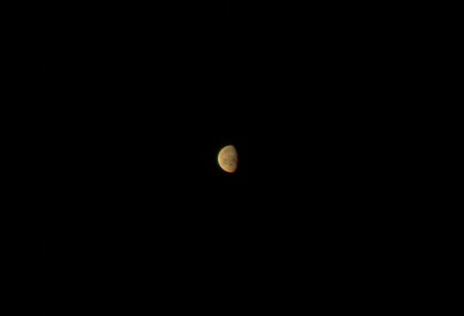
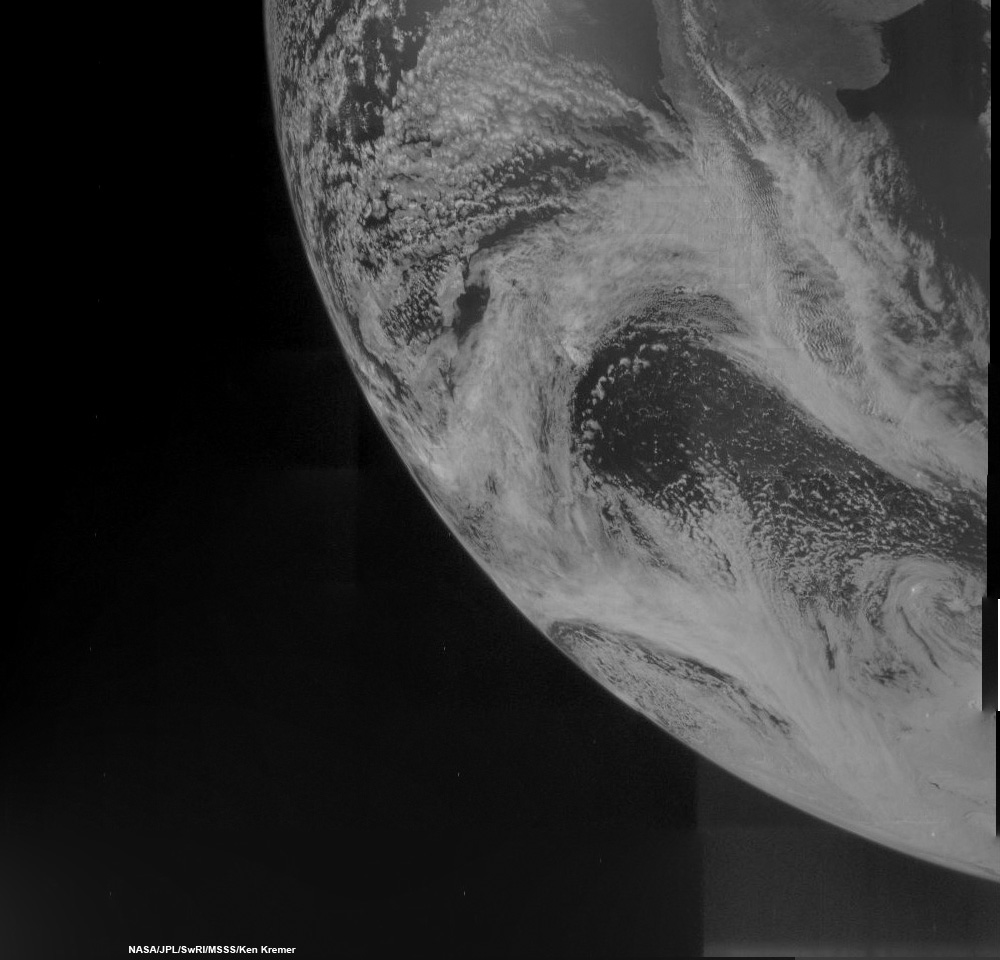

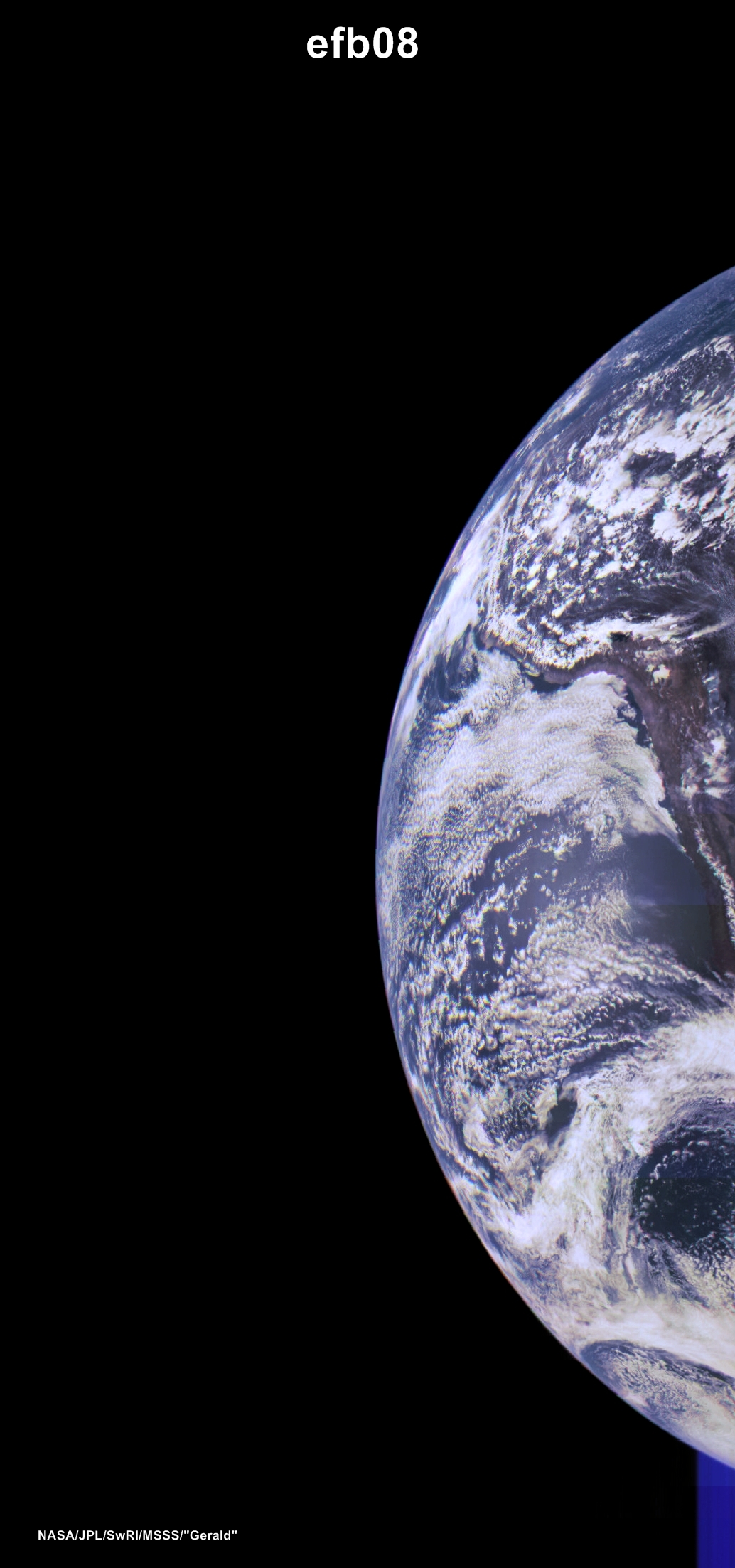
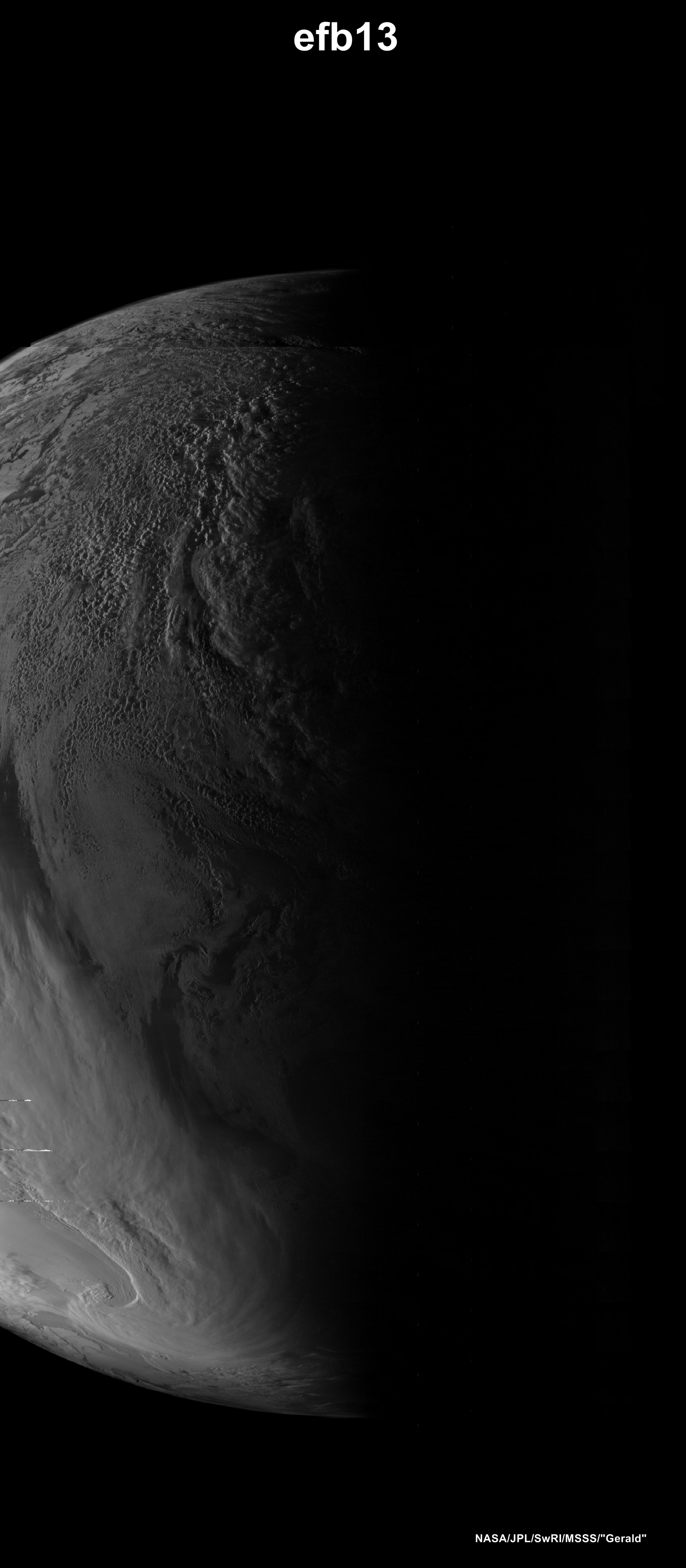

NASA's Juno mission to Jupiter has broken the record to become humanity's most distant solar-powered emissary. The milestone occurred at 11 a.m. PST (2 p.m. EST, 19:00 UTC) on Wednesday, Jan. 13, when Juno was about 493 million miles (793 million kilometers) from the sun.
The previous record-holder was the European Space Agency's Rosetta spacecraft, whose orbit peaked out at the 492-million-mile (792-million-kilometer) mark in October 2012, during its approach to comet 67P/Churyumov-Gerasimenko.
"Juno is all about pushing the edge of technology to help us learn about our origins," said Scott Bolton, Juno principal investigator at the Southwest Research Institute in San Antonio. "We use every known technique to see through Jupiter's clouds and reveal the secrets Jupiter holds of our solar system's early history. It just seems right that the sun is helping us learn about the origin of Jupiter and the other planets that orbit it."
Launched in 2011, Juno is the first solar-powered spacecraft designed to operate at such a great distance from the sun. That's why the surface area of solar panels required to generate adequate power is quite large. The four-ton Juno spacecraft carries three 30-foot-long (9-meter) solar arrays festooned with 18,698 individual solar cells. At Earth distance from the sun, the cells have the potential to generate approximately 14 kilowatts of electricity. But transport those same rectangles of silicon and gallium arsenide to a fifth rock from the sun distance, and it's a powerfully different story.
"Jupiter is five times farther from the sun than Earth, and the sunlight that reaches that far out packs 25 times less punch," said Rick Nybakken, Juno's project manager from NASA's Jet Propulsion Laboratory in Pasadena, Calif. "While our massive solar arrays will be generating only 500 watts when we are at Jupiter, Juno is very efficiently designed, and it will be more than enough to get the job done."
[...]
https://www.missionjuno.swri.edu/news/mission-status-may-6-2016As of May 6, 2016, Juno is approximately 450 million miles (724 million kilometers) from Earth. The one-way radio signal travel time between Earth and Juno is currently about 40 minutes.
Juno is traveling at a velocity of approximately 60,000 miles per hour (about 26.9 kilometers per second) relative to Earth, 15,000 miles per hour (about 6.7 kilometers per second) relative to the Sun, and 13,000 miles per hour (about 6 kilometers per second) relative to Jupiter. Juno has now travelled 1.74 billion miles (2.8 billion kilometers, or 18.73 AU) since launch, and has another 19 million miles to go (31 million kilometers, or 0.20 AU) before entering orbit around Jupiter.
The Juno spacecraft is in excellent health and is operating nominally.
Today (6/24), at exactly 9:57 and 48 seconds a.m. PDT, NASA's Juno spacecraft was 5.5 million miles (8.9 million kilometers) from its July 4th appointment with Jupiter. Over the past two weeks, several milestones occurred that were key to a successful 35-minute burn of its rocket motor, which will place the robotic explorer into a polar orbit around the gas giant.
"We have over five years of spaceflight experience and only 10 days to Jupiter orbit insertion," said Rick Nybakken, Juno project manager from NASA's Jet Propulsion Laboratory in Pasadena, California. "It is a great feeling to put all the interplanetary space in the rearview mirror and have the biggest planet in the solar system in our windshield."
...
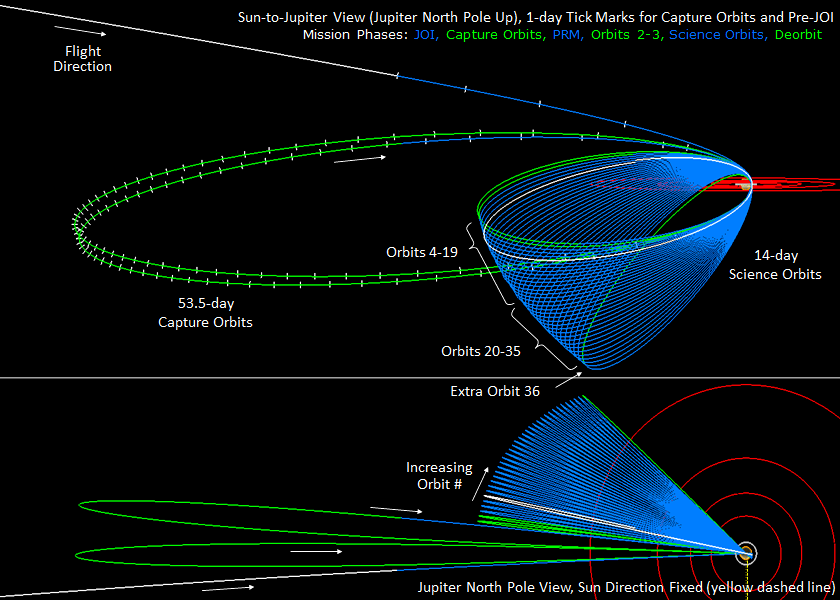
Although other spacecraft have previously visited Jupiter, the space around the planet is full of unknowns, especially the regions above the poles. With these challenges in mind, the Juno team has been busy fine-tuning their flight plan.
[...]
Following a detailed analysis by the Juno team, NASA recently approved changes to the mission's flight plan at Jupiter. Instead of taking 11 days to orbit the planet, Juno will now complete one revolution every 14 days. The difference in orbit period will be accomplished by having Juno execute a slightly shorter engine burn than originally planned.
The revised cadence will allow Juno to build maps of the planet's magnetic and gravity fields in a way that will provide a global look at the planet earlier in the mission than the original plan. Over successive orbits, Juno will build a virtual web around Jupiter, making its gravity and magnetic field maps as it passes over different longitudes from north to south. The original plan would have required 15 orbits to map these forces globally, with 15 more orbits filling in gaps to make the map complete. In the revised plan, Juno will get very basic mapping coverage in just eight orbits. A new level of detail will be added with each successive doubling of the number, at 16 and 32 orbits.
The slightly longer orbit also will provide a few extra days between close approaches to the planet for the team to react to unexpected conditions the spacecraft might experience in the complex environment very close to Jupiter.
[...]
The revised plan lengthens Juno's mission at Jupiter to 20 months instead of the original 15, and the spacecraft will now complete 32 orbits instead of 30. But the extra time doesn't represent bonus science for the mission -- rather, it's an effect of the longer orbital period and the change in the way Juno builds its web around Jupiter. Basically, it will take Juno a bit longer to collect the full data set the mission is after, but it will get a low-resolution version of its final products earlier in the mission than originally planned.
NASA also recently approved a change to the spacecraft's initial orbit after Jupiter arrival, called the capture orbit. The revised plan splits the originally planned, 107-day-long capture orbit into two. The new approach will provide the Juno team a sneak preview of their science activities, affording them an opportunity to test the spacecraft's science instruments during a close approach to Jupiter before beginning the actual science phase of the mission. The original scenario called for an engine burn to ease Juno into Jupiter orbit, followed by a second burn 107 days later, putting the spacecraft into an 11-day science orbit. In the updated mission design, the orbit-insertion burn is followed 53.5 days later by a practice run at Jupiter with science instruments turned on, followed by another 53.5-day orbit before the final engine burn that places Juno into its new, 14-day science orbit.
[...]
NASA's Juno spacecraft will make its long anticipated arrival at Jupiter on July 4. Coming face-to-face with the gas giant, Juno will begin to unravel some of the greatest mysteries surrounding our solar system's largest planet, including the origin of its massive magnetosphere.
Magnetospheres are the result of a collision between a planet's intrinsic magnetic field and the supersonic solar wind. Jupiter's magnetosphere – the volume carved out in the solar wind where the planet’s magnetic field dominates –extends up to nearly 2 million miles (3 million kilometers). If it were visible in the night sky, Jupiter's magnetosphere would appear to be about the same size as Earth’s full moon. By studying Jupiter's magnetosphere, scientists will gain a better understanding about how Jupiter's magnetic field is generated. They also hope to determine whether the planet has a solid core, which will tell us how Jupiter formed during the earliest days of our solar system.
In order to look inside the planet, the science team equipped Juno with a pair of magnetometers. The magnetometers, which were designed and built by an in-house team of scientists and engineers at NASA's Goddard Space Flight Center in Greenbelt, Maryland, will allow scientists to map Jupiter's magnetic field with high accuracy and observe variations in the field over time.
[...]
